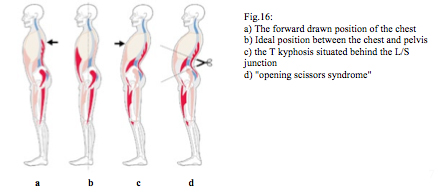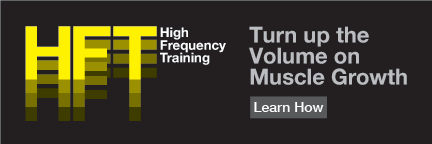I recently spent four days at USC’s Movement Performance Institute studying Dynamic Neuromuscular Stabilization (DNS) with Dr. Petra Valouchova, Dr. Craig Liebenson, and their associates. It was terrific training that progressed my knowledge for building strength and athleticism. DNS is an approach out of Prague, developed by the outstanding physiotherapist Dr. Pavel Kolar, that gets its roots from developmental kinesiology.
The DNS-Sport training starts by teaching you how to stabilize the torso with specific techniques that put the ribcage and pelvis back in proper alignment. In particular, many people suffer from some degree of the “opening scissors syndrome” which can be caused by anterior pelvic tilt, an elevated ribcage, or both.

So the first goal of DNS is to re-establish proper posture as shown above the letter “b.” In DNS training I learned how essential proper diaphragm function is for training and posture. That function hinges on the correct breathing patterns that re-align the ribcage and pelvis, and it’s this proper alignment along with elevated intra-abdominal pressure that boost your strength and performance during sport.
The saying, “You can’t shoot a cannon from a canoe” sums up the importance of spinal stability whether you’re a professional athlete or a hard-training fitness enthusiast. A more powerful body requires higher levels of stability. Too often people will jump straight to the advanced stuff like Olympic lifts before building a stable base. The positions that DNS emphasize help bridge the gap between stability and power.
I should mention here that many of the most valuable DNS techniques come from proper cueing and instruction throughout various movements. In other words, it takes a lot of practical experience to really understand and feel the effects of improving neuromuscular stabilization with the DNS approach.
With that in mind, here’s one move I learned that helps correct the “scissors” posture many of us battle. One key element of the exercise below is that your breathing pattern should remain normal. This isn’t intended to be an intense strength training exercise – it’s a drill to help put the ribcage and pelvis back in proper alignment.
From there, DNS builds on neuromuscular patterns that were developed during the first year of life. Even though DNS was primarily intended for rehabilitation purposes, the exercises and positions they teach can be applied to strength training.
For example, one position that’s emphasized in DNS is the modified side plank, a mid-transition position between lying on your back and standing. I’ve been having my clients hold the modified side plank while they perform various presses and pulls because it’s an excellent way to build spinal stability and strengthen the muscles around the pelvis. Also, the position is stable enough to allow you to train with moderately heavy loads.
In the near future I’ll be showing more exercises that revolve around these novel positions, but in the meantime, here’s a video of me doing a kettlebell press from the modified side plank.
DNS is a complex approach that addresses posture, movement, joint centration, intra-abdominal pressure, etc. so there’s plenty that needs to be said beyond the few things I mentioned here. If you’re interested in learning more about the philosophy and development of DNS, you can read this overview from Dr. Craig Liebenson.
Stay Focused,
CW

